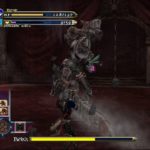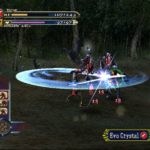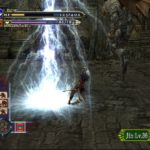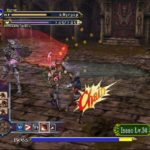Developer: KCET Publisher: Konami Released: 11/01/05 Genre: Action Platforms: PS2, Xbox
Castlevania: Lament of Innocence went a long way towards redeeming the series after two failed N64 outings. It established a clear beginning for the rivalry between the Belmont clan and Dracula and laid the groundwork for the series going forward. It also had glaring flaws that were hard to ignore, that being boring level design and lacking RPG elements. Curse of Darkness seeks to iron out those flaws and is mostly successful in that endeavor. It too introduces its own set of problems that keep it from being the excellent game it almost is.
Storyline wise Curse of Darkness is a direct sequel to Castlevania III. After Trevor Belmont successfully defeats Dracula evil still has not left the land. Three years later and Dracula’s Curse still haunts the land, the work of one Dracula’s devil forgemasters named Isaac. His rival Hector, a reformed devil forgemaster himself, returns to the ruins of Dracula’s castle to find Isaac and enact revenge.
It’s an interesting premise but the game does very little with it. Outside of fighting Trevor a few times you would be hard pressed to know this ties in to Castlevania III. The story itself can be confusing; the sparse cutscenes feature nonsensical dialogue with many allusions to events that will allegedly happen in the future. Those events are still MIA as Konami went into a spiral that saw an exodus of talent and the series going in a different direction. Oh well.
It is clear from the onset that the game took the criticisms of its predecessor in mind. Almost every system has seen a redesign with the largest changes going to combat. The game provides numerous reasons to engage enemies. You gain experience and level up as in Symphony of the Night but it goes beyond that. Hector does not wield a whip but instead one of many crafted weapons. Weapons fall into five categories (sword, axe, spear, fist, special) and each possesses various multi-hit combos. All equipment is crafted using materials found or dropped by enemies. The system runs deep; crafting one item will often earn new recipes and it cascades frequently. The list of weapons is pretty diverse with many two-handers and even joke weapons such as a spiked bat thrown in. It allows you to customize your play style to a degree and I love it.
Another reason to frequently engage with enemies is stealing. I’ll be the first to admit I’ve never been fond of stealing in most games. But the implementation here is incredibly fun and worthwhile. When locked onto an enemy you wait for their vulnerability window, indicated by a purple cursor. The timing varies with every enemy and it is insanely fun to experiment. You can even steal from bosses to earn late game crafting material early on. Stealing also serves another purpose; earning money. The game is stingy with gold so stealing from enemies or selling materials is the main way to gain currency. Not that it is necessary since you’ll create most of what you need. But this system does further incentivize engaging in combat.
Possibly the greatest addition are the innocent devils. These are like Symphony of the Night’s familiars on steroids. Devils fall into five families with specific behaviors. Fairies focus on healing while battle and devils assist in combat. They level up independent of Hector and can either go off on their own or controlled manually. Even better, they evolve into new forms based on the weapon you are using with wildly different powers. Particular devils are necessary to access many of the game’s secrets but that is optional. They are incredibly helpful and in some cases broken: you can earn a Corpsey early on and he is so powerful that you can sit back and let him do all the work. Innocent devils are a great addition and really spice up the game.
For every one problem Curse of Darkness solved it introduces another. The main culprits are the camera and the lock-on function. The game offers full camera control rather a fixed camera. For the most part it works but in close quarters or anytime the elevation changes it needs babysitting. There is no button to automatically re-orient it so you have to slowly turn it around constantly. This goes hand in hand with the lock-on targeting’s stupid behavior. It will frequently target the most distant enemy, sometimes even ones that are far away or off camera. With this you are constantly open to cheap hits while frantically trying to correct it. It happens often enough that it brings the game down, especially since you need it to steal from enemies. I really wish these important functions were better as they bring the game down.
My main criticism of Lament of Innocence came down to its drab level design. Every room was a square box and it was littered with repetitive hallways. Now the game takes place primarily outside with frequent changes in venue for variety. But it also trades one problem for another. The repetitious corridors have given way to large open rooms. The problem is there is nothing interesting to see. Every area is straightforward, with an occasional fork. With no run button you slowly jog through long stretches of generic scenery in every zone. The pacing is terrible and if it weren’t for the great combat mechanics I would find it worse than its predecessor.
Yet despite these faults Curse of Darkness is still fun. As I’ve mentioned the combat mechanics are sound and there are enough secrets that you’ll still end up playing long after the final boss has been defeated. The game also has a stellar soundtrack but that is par for the course with this series. My disappointment stems from the game’s potential. It has everything it needs to be a truly amazing game but has enough flaws that it is merely good.
In Closing
That being said it is still worth playing, even today. Castlevania: Curse of Darkness lags behind action greats like Ninja Gaiden but is still entertaining. Go in knowing its flaws and you will enjoy it.













